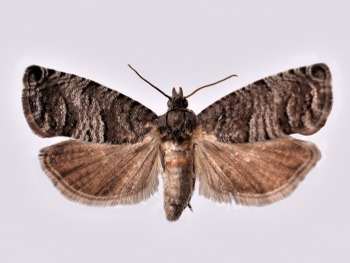Pests
Laspeyresia pyrivora (Danilevsky) - Pear Moth.
Systematic position.
Class Insecta, order Lepidoptera, family Tortricidae, subfamily Olethreutinae, tribe Grapholitini, genus Cydia.Synonyms.
Cydia pyrivora Danil., Carpocapsa dannechli Obr., C. pyrivora Dan.Biological group.
It is an oligophagous pest of pear.Morphology and biology.
C. pyrivora is similar to the Codling Moth in size and in the shape of the wings. Forewings are grayer, with more clearly pronounced transversal sinuate lines (wingspan is 17-22 mm). Apical reddish-brown spot has a silvery or leaden tint. Hind wings are dark, brownish-gray. Marginal fringe has a darker line at base. Egg is flattened, red in the beginning, subsequently pink-gray, finally yellow-gray. Caterpillar is 11-17 mm long, dirty-white, with yellow-brown head. Pupa is dark brown, located in a dense cherry-black cocoon, 11-13 mm long. Fertility is 35-80 eggs on the average; the majority of eggs are laid in upper and middle layers of crown. Female lays eggs on surface of fruits only, mainly in their middle part, one by one, 3-8 days after emergence. The period of egg-laying lasts for 34-41 days depending on temperature and other environmental factors. Eggs develop in 4-10, usually 5-6 days. Caterpillar gnaws through bottom of egg capsule, boring inside fruit. In contrast to the Codling Moth caterpillar, it gnaws a strictly straight and always clean hole toward seed chamber, and then penetrates into one of the seeds. Gradually the caterpillar eats the entire seed, filling the seed chamber with brown excrement, and then passing into another chamber. It does not pass into another fruit. The period of development of caterpillars lasts 22 (in the south) to about 45 days (in the north). Fattened caterpillars cocoon in the vegetative residues and in upper layer of ground (to 5 cm) at tree trunks, especially on turf-covered plots. Diapausing caterpillars winter in cocoons. Pupae develop over 2-3 weeks.Distribution.
This species occurs in Central and Southern Europe, Asia Minor, Syria and on Crete. In the territory of the former USSR it is distributed in forest-steppe and steppe zones of the European part (Central-Chernozem Region, Moldova, Ukraine, Ciscaucasia, Transcaucasia, mountains of Uzbekistan).Ecology.
The species is ecologically related to mesophilic wild-growing species of pear. Everywhere it is monovoltine. Moth flight begins in the later part of June in the north of the Ukraine and in the Belgorod Region, and in the first part of June in the steppe zone at average daily temperatures of 15°C and higher. Degree days at this time are approximately 370-400° (above 10°C). The period of mass flight occurs at temperatures of 19-26°C. Moths fly until the end of July or beginning of August. Imagoes live 7-10, maximum 17 days. Hatching of caterpillars starts from the last third of June, at degree days 560°, lasting about 40 days. Mass hatching takes place in the last third of June or in the first third of July. Caterpillars leave fruits that are still hanging, from the later part of July until the middle of August. They are susceptible to low temperatures (-25°C); individuals only survive wintering under snow. Reactivation occurs under the influence of low temperatures (0-5°C) and high humidity levels (75% or higher). Contact moisture at high temperatures can cause mass pupation of almost 90% of caterpillars. Pupation begins in spring in the later part of May, mass pupation occurs at the end of May and the beginning of June. Degree days 170° is necessary for pupation.Economic significance.
Caterpillars cause harm to cultivars and also to wild-growing European and Caucasian species of pear, such as Pyrus communis and P. caucasica. The wild pears growing in wind-proof belts are a serious source of the pest migration to orchards. Early large-fruited varieties of pear are most strongly affected in the north of the Ukraine and in the Belgorod Region as the period of caterpillar hatching coincides with a phase of wax ripeness of seeds that are more suitable for feeding. Seedless varieties are unsuitable for the development of caterpillars. In Moldova the greatest harm is caused to later varieties. Control measures include agronomical (plowing of ground under trees for destruction of wintering individuals; duly collecting and destroying fruits that drop) and chemical methods (treatment by contact insecticides during moth flight and egg laying). Sex pheromone is identified.Reference citations:
Danilevskii A.S. 1947. New tortricid species harming to pear in the European part of the USSR. Doklady AN SSSR, 58(7): 1555-1556. (In Russian)Danilevskii A.S., Kuznetsov V.I. 1968. Tortricidae, tribe Laspeyresiini. In: Bykhovskii B.E., ed. Fauna of the USSR, New Ser., N. 98. Lepidoptera. V. 5(1). Moscow-Leningrad: AN SSSR. 636 p. (In Russian)
Danilevskii A.S., Shel.deshova G.G. 1950. Biology and morphological features of Carpocapsa pyrivora Dan. Zoologicheskii zhurnal, 29(1): 69-81. (In Russian)
Kostyuk Yu.A. 1974. Family Tortricidae. In: Vasil.ev V.P., ed. Pests of agricultural crops and forest plantations. V. 2. Arthropods. Kiev: Urozhai. 261-320 p. (In Russian)
Kuznetsov V.I. 1994. Family Tortricidae. In: Kuznetsov V.I., ed. Insects and mites - pests of agricultural plants. V. 3(1). Lepidoptera. St. Petersburg: Nauka. 51-234 p. (In Russian)
Shel.deshova G.G. 1958. Biology of Carpocapsa pyrivora Danil. In: Danilevskii A.S., ed. Insect ecology. Uchenye zap. LGU. N. 240, Ser. Biol., 46. Leningrad: LGU. 88-121 p. (In Russian)
Vasil.ev V.P., Livshits I.Z. 1984. Pests of fruit crops. Moscow: Kolos. 399 p. (In Russian)


